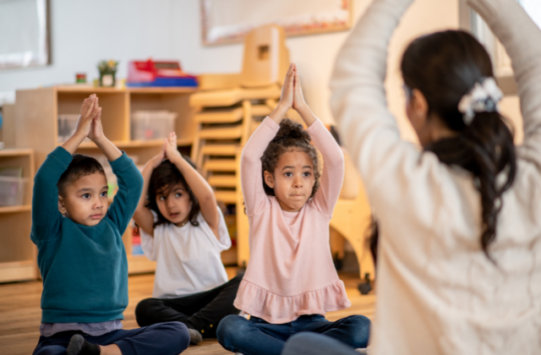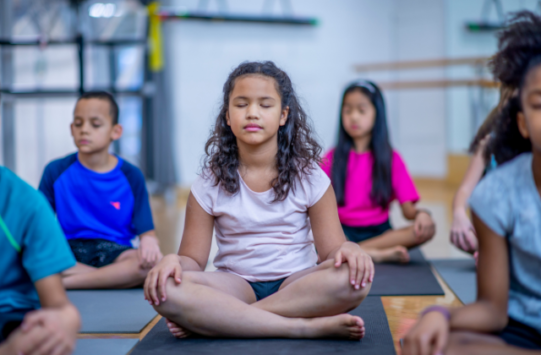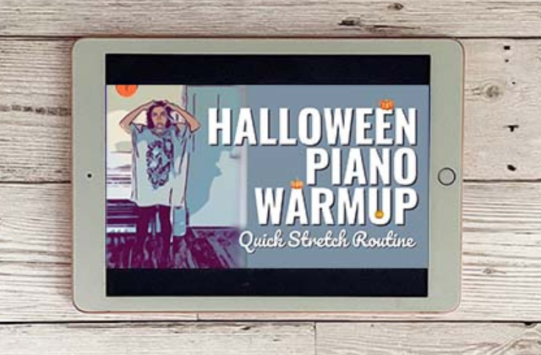
This article about mindfulness for piano students was written by Joanna Shiel. Joanna works on the editorial team for Virbant Music Teaching. She’s been teaching for 14 years, both in-person and online. In her spare time, she loves hiking, spending time in nature and discovering new places to eat out.
Performing can be scary. Sweaty palms, shaky legs and fingers that just won’t do what they’re told. Are all the butterflies and jitters actually just in the mind? And if they are, how can we help our students overcome the tricks their psyche might be playing on them?

The mind is incredibly powerful, and can make or break a performance. I believe that part of our jobs as piano teachers is to help our students gain control over their thoughts and keep their cool when performing.
A lot of you may have heard of mindfulness since it’s widely held to be an exceptional practice for reducing anxiety and stress. But if you’re not familiar with it, mindfulness is simply a way to focus your mind on the moment you’re in, while accepting and appreciating – without judgement – all thoughts, feelings and bodily reactions you’re experiencing.
Since mindfulness is a powerful practice to manage nerves and stress, how can we make it a natural part of piano lessons so students have a source of strength to draw on when they‘re about to step out on stage for performances?
Introducing Mindfulness
I live by this principle: What we do regularly, we can draw from easily.
As you make mindfulness part of every piano lesson, right from the start, your students will eventually begin to use this helpful tool when faced with anxiety-inducing situations.
When I first introduce mindfulness to a student, I like to ask how they usually react when they feel anxious or nervous. (If they struggle to come up with an answer, we brainstorm together to find a time when they’ve felt nervous, such as reading out loud to their class.)
Coming up with examples of nerve-generating circumstances serves as a good starting point for most students. This activity can also serve as a bridge as you establish mindfulness habits into your lessons.
5 Mindfulness Anchors
I encourage you to test out these 5 mindfulness practices to see which ones really vibe with your piano students and become anchors as your students face the typical nerves and jitters associated with performances.
Anchor No. 1: Yoga and Stretching
I like to include a few yoga movements in lessons. Yoga is a great way to move with the breath, inhaling once in position, and exhaling when moving to a new pose.

Here’s a simple yoga position that any student can try:
- Stand in mountain pose (feet hip-width apart, arms to each side with open hands, palms facing forward)
- Transition your hands into fists
- Without moving your arms, curl your wrists up and down
If you need more ideas for including yoga in music lessons, Nicola has a great post on yoga poses she likes to use in her lessons.
Yoga is a beautiful anchor to bring awareness to the body, focussing the mind on the present and connecting breath to movement.
Anchor No. 2: Warm-Ups
Have you tried any of the VMT warmups? If yoga isn’t quite right for you or your students, try one of the warmup collections in the VMT Library.
These fun movement activities will get your students traipsing through tropical rainforests, haunted houses, the polar ice caps and the seven seas. Each warmup includes a video you can use to help you prepare, or share with your students during an online lesson.
For example, ‘Stiff Leg Lifts’ is an easy warmup from the ‘Half-Minute Halloween Warmup For Zombies’:
- Stand upright
- Put your hands on your head
- Lift each leg, keeping them stiff
This warmup may seem simple, or even silly. The magic, however, comes from the amazing zombie graphics and creepy music; students simply can’t get enough. (Can you imagine Nicola as a zombie? If you’re a member of VMT, you don’t have to imagine – you can see it in the warmup video!)
Not a member? Join today so you, too, can join the zombie warmup movement!
Anchor No. 3: Helpful Thoughts
With each of your students, make a list of helpful thoughts they can use when faced with a nerve-wracking circumstance.
These affirmations will be totally unique to each student. Keep them in a notebook to pull out whenever your student encounters a difficult situation.
Having this list available is particularly important when a student is quite anxious about an upcoming performance or exam. Remind them of their helpful thoughts and encourage them to memorise some to combat big emotions.
You might even want to make huge posters of these supportive thoughts to keep around your studio. Seeing these affirmations every time they come into lessons gives students something physical to point to, and can help embed the positive guidance.
Perhaps you can encourage students to create their own affirmation posters to keep at home if this anchor works for them.
Anchor No. 4: Embracing Emotion
Feelings like anxiety, stress, fear and frustration can feel all-consuming to young students. But all emotions are important and there should be room for them.
When we quash emotions some might consider “negative”, it can cause those feelings to build up and explode. 🤯
You might need to help students identify feelings by providing examples, such as, “I got really nervous during my last performance. My heart was racing and I had sticky palms.” Or, “I find it frustrating when I try to play a section and I just can’t get it!”
Encourage students to explore reasons that what they’re feeling is actually a good thing. This can be tricky but it’s so worthwhile.
For example, if your student is feeling afraid to perform piano in front of their parents, this could mean they really want to do a good job of playing the piece. The desire to do their best is cause for celebration!
Anchor No. 5: Breathwork
Breathing is a really simple and powerful anchor. When we get nervous or anxious, one of the first things to go is breathing. Yet, when we cut off oxygen to our brain, we stop ourselves from being able to think clearly.

Here’s a simple breathing exercise you can do with your students straightaway:
- Practise breathing deeply: in through the nose and out through the mouth (“Smell the flowers and blow out the candles.”)
- Counting together, inhale for 1-2-3-4-5, then exhale for 1-2-3-4-5
- Make sure to count out loud (in a whisper), especially at the same time, so the mind can focus on something
I love to bring in breathing exercises whenever I see that a student is becoming overwhelmed and nervous, or is stumbling through a practice performance.
For more helpful advice on teaching technique, visit Nicola’s ‘Planning Lessons’ hub page.
What mindfulness anchor are you going to try this week?
I’d love to hear your ideas in the comments below.
If you liked this article, you’ll love the game ‘Unicorn Horncraft’, which helps students learn to embrace mistakes and quickly recover from them. Enter your info below and Nicola will send the game right to your inbox.

Subscribe to the newsletter and get unicorn horncraft
Enter your details to subscribe to the newsletter for piano teachers with information, tips and offers.
I hate spam as much as you do! I will only send you emails related directly to piano teaching and you can unsubscribe at any time.
VMT Members can download Unicorn Horncraft instantly. Haven’t heard of the membership program yet? You’ve got to check it out – you won’t believe all the resources members have at their fingertips!
